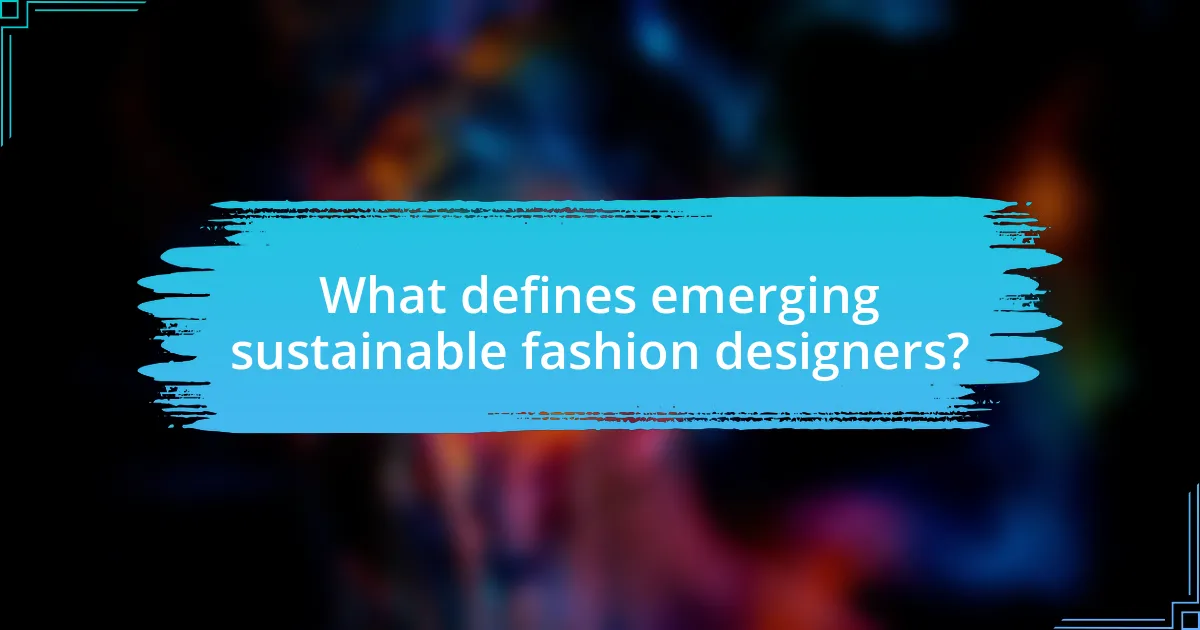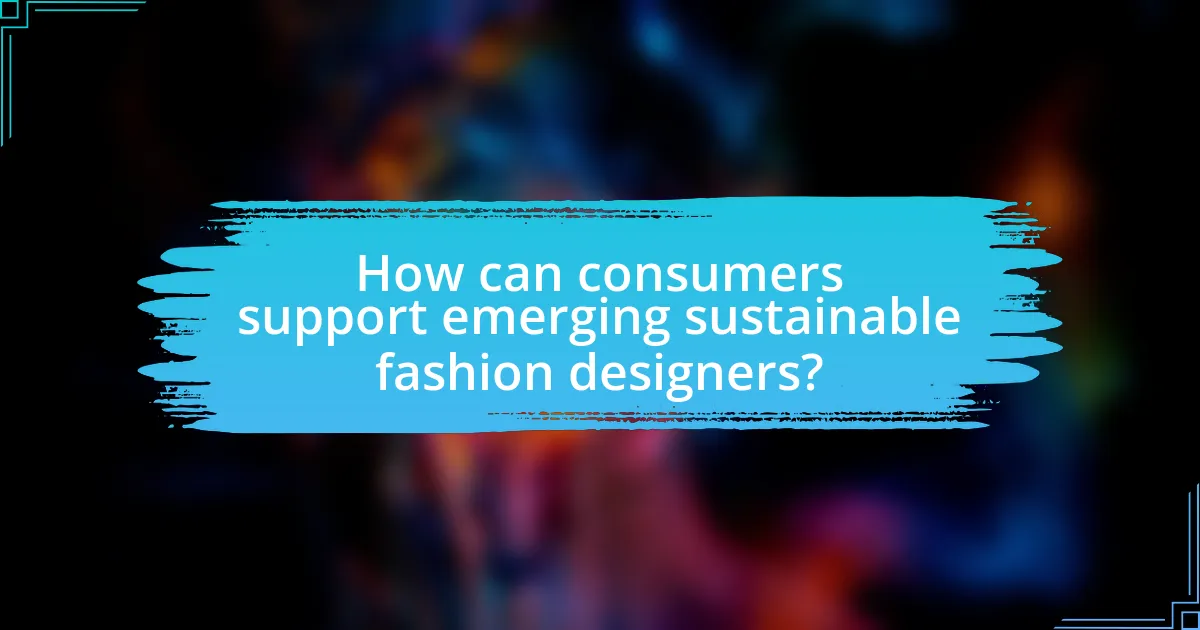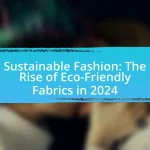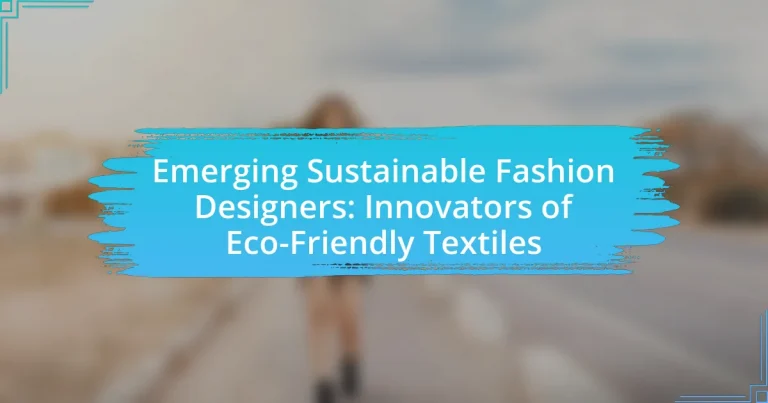Emerging sustainable fashion designers are characterized by their dedication to eco-friendly practices, innovative materials, and ethical production processes. They utilize organic, recycled, and biodegradable textiles to minimize environmental impact and promote social responsibility within the fashion industry. The article explores how these designers contribute to eco-friendly textiles, the materials they typically use, and the environmental consequences of traditional fashion practices. It also highlights notable designers, innovative techniques, and the philosophies driving this movement, while discussing the role of technology and consumer behavior in shaping sustainable fashion. Additionally, it addresses the challenges faced by these designers and offers practical steps for consumers to support sustainable fashion initiatives.

What defines emerging sustainable fashion designers?
Emerging sustainable fashion designers are defined by their commitment to eco-friendly practices, innovative use of materials, and a focus on ethical production processes. These designers prioritize sustainability by utilizing organic, recycled, or upcycled textiles, which significantly reduce environmental impact. For instance, a report by the Global Fashion Agenda highlights that sustainable materials can reduce greenhouse gas emissions by up to 80% compared to conventional fabrics. Additionally, emerging designers often engage in transparent supply chains, ensuring fair labor practices and minimizing waste through techniques like zero-waste pattern making. This holistic approach not only addresses environmental concerns but also promotes social responsibility within the fashion industry.
How do these designers contribute to eco-friendly textiles?
Emerging sustainable fashion designers contribute to eco-friendly textiles by utilizing innovative materials and sustainable production methods. These designers often prioritize organic, recycled, or biodegradable fabrics, reducing reliance on harmful chemicals and non-renewable resources. For instance, brands like Stella McCartney use organic cotton and recycled polyester, which significantly lower environmental impact compared to conventional textiles. Additionally, many of these designers implement ethical labor practices and local sourcing, further minimizing carbon footprints and supporting community economies. This holistic approach not only promotes sustainability but also sets industry standards for eco-conscious practices.
What materials do emerging sustainable fashion designers typically use?
Emerging sustainable fashion designers typically use organic cotton, Tencel, hemp, recycled polyester, and biodegradable materials. Organic cotton is favored for its reduced environmental impact compared to conventional cotton, as it is grown without synthetic pesticides and fertilizers. Tencel, made from sustainably sourced wood pulp, is known for its biodegradability and low water usage in production. Hemp is valued for its durability and minimal need for chemical treatments. Recycled polyester, derived from post-consumer plastic bottles, helps reduce waste and reliance on virgin materials. Biodegradable materials, such as those made from natural fibers or innovative plant-based alternatives, are increasingly utilized to minimize long-term environmental impact.
How do these materials impact the environment?
Eco-friendly textiles significantly reduce environmental impact by minimizing waste, lowering carbon emissions, and using sustainable resources. For instance, organic cotton requires 91% less water than conventional cotton and avoids harmful pesticides, which can contaminate soil and water. Additionally, materials like Tencel, made from sustainably sourced wood pulp, utilize a closed-loop production process that recycles water and solvents, resulting in lower pollution levels. Research indicates that adopting these materials can lead to a 30% reduction in greenhouse gas emissions compared to traditional textile production methods.
Why is sustainability important in the fashion industry?
Sustainability is important in the fashion industry because it addresses environmental degradation, social inequality, and economic viability. The fashion industry is one of the largest polluters globally, contributing to significant waste and carbon emissions; for instance, it accounts for about 10% of global carbon emissions and is responsible for 20% of wastewater. By adopting sustainable practices, such as using eco-friendly materials and ethical labor practices, the industry can reduce its environmental footprint and promote social responsibility. This shift not only helps in conserving resources but also meets the growing consumer demand for ethical products, as studies show that 66% of consumers are willing to pay more for sustainable brands.
What are the environmental consequences of traditional fashion practices?
Traditional fashion practices lead to significant environmental consequences, including high levels of pollution, resource depletion, and waste generation. The fashion industry is responsible for approximately 10% of global carbon emissions, primarily due to energy-intensive production processes and transportation. Additionally, conventional textile manufacturing consumes vast amounts of water; for instance, producing a single cotton t-shirt requires about 2,700 liters of water, contributing to water scarcity in many regions. Furthermore, traditional practices often result in substantial textile waste, with an estimated 92 million tons of textiles discarded annually, exacerbating landfill issues and environmental degradation. These factors highlight the urgent need for sustainable alternatives in the fashion industry.
How does sustainable fashion address these issues?
Sustainable fashion addresses environmental and social issues by promoting eco-friendly materials, ethical production practices, and waste reduction. By utilizing organic, recycled, or biodegradable textiles, sustainable fashion minimizes the ecological footprint associated with conventional textile manufacturing, which often involves harmful chemicals and excessive water usage. For instance, the Global Fashion Agenda reports that the fashion industry is responsible for 10% of global carbon emissions, and sustainable practices can significantly reduce this impact. Additionally, sustainable fashion emphasizes fair labor practices, ensuring that workers receive fair wages and safe working conditions, which counters the exploitative practices often found in fast fashion. This holistic approach not only mitigates environmental damage but also fosters social equity within the industry.

Who are some notable emerging sustainable fashion designers?
Notable emerging sustainable fashion designers include Marine Serre, known for her upcycled materials and innovative designs, and Tada & Toy, which focuses on zero-waste patterns. Additionally, designers like Rejina Pyo and A.B.C. (A Better Choice) are gaining recognition for their commitment to ethical production and sustainable practices. These designers exemplify the shift towards eco-friendly textiles and responsible fashion, contributing to a more sustainable industry.
What innovative techniques do these designers employ?
Emerging sustainable fashion designers employ techniques such as upcycling, zero-waste pattern making, and the use of biodegradable materials. Upcycling transforms discarded textiles into new garments, reducing waste and promoting circular fashion. Zero-waste pattern making involves designing clothing in a way that eliminates fabric waste during production, which has been shown to significantly decrease environmental impact. Additionally, the use of biodegradable materials, such as organic cotton and Tencel, ensures that garments decompose naturally, minimizing pollution. These techniques collectively contribute to a more sustainable fashion industry by addressing waste and resource consumption.
How do these techniques differ from conventional fashion design methods?
Emerging sustainable fashion design techniques differ from conventional methods primarily by prioritizing eco-friendly materials and processes. Conventional fashion design often emphasizes mass production and fast fashion, leading to significant waste and environmental harm. In contrast, sustainable techniques focus on using organic, recycled, or biodegradable materials, which reduces the ecological footprint. For example, designers like Stella McCartney utilize innovative textiles made from recycled plastics, demonstrating a commitment to sustainability that conventional methods typically overlook. This shift not only addresses environmental concerns but also promotes ethical labor practices, contrasting sharply with the often exploitative labor conditions found in traditional fashion manufacturing.
What role does technology play in their designs?
Technology plays a crucial role in the designs of emerging sustainable fashion designers by enabling innovative eco-friendly textile production and enhancing design processes. Advanced technologies such as 3D printing and digital fabric printing allow designers to create intricate patterns and reduce waste by producing only what is necessary. Additionally, technologies like blockchain provide transparency in the supply chain, ensuring ethical sourcing of materials. Research indicates that the integration of technology in sustainable fashion can reduce water usage by up to 90% in some textile production processes, demonstrating its significant impact on environmental sustainability.
What are the key philosophies driving these designers?
The key philosophies driving emerging sustainable fashion designers include a commitment to environmental stewardship, ethical production practices, and a focus on circularity. These designers prioritize the use of eco-friendly materials, such as organic cotton and recycled fibers, to minimize their ecological footprint. They advocate for fair labor practices, ensuring that workers are treated ethically and compensated fairly. Additionally, many of these designers embrace circular fashion principles, promoting the idea of designing for longevity and recyclability, which reduces waste and encourages sustainable consumption. This approach is supported by the growing consumer demand for transparency and sustainability in the fashion industry, as evidenced by reports indicating that 66% of global consumers are willing to pay more for sustainable brands.
How do these philosophies influence their design choices?
Emerging sustainable fashion designers prioritize eco-friendly practices, which significantly influence their design choices. These designers often select materials that are biodegradable, recycled, or sourced sustainably, reflecting a commitment to reducing environmental impact. For instance, many utilize organic cotton or Tencel, which require less water and chemicals compared to conventional fabrics. Additionally, their design processes frequently incorporate zero-waste techniques, ensuring that fabric scraps are minimized or repurposed. This approach not only conserves resources but also promotes a circular economy within the fashion industry. By embracing these philosophies, designers create garments that align with ethical standards and appeal to environmentally conscious consumers, thereby fostering a more sustainable future in fashion.
What impact do these philosophies have on consumer behavior?
Sustainable fashion philosophies significantly influence consumer behavior by increasing awareness and preference for eco-friendly products. Consumers are increasingly prioritizing sustainability, leading to a shift in purchasing decisions towards brands that demonstrate ethical practices and environmental responsibility. Research indicates that 66% of global consumers are willing to pay more for sustainable brands, reflecting a growing trend towards conscious consumption. This shift is driven by factors such as environmental concerns, social responsibility, and the desire for transparency in the fashion industry. As a result, emerging sustainable fashion designers who adopt these philosophies can attract a more engaged and loyal customer base, ultimately reshaping market dynamics.

How can consumers support emerging sustainable fashion designers?
Consumers can support emerging sustainable fashion designers by purchasing their products directly from their brands. This financial support enables designers to continue creating eco-friendly textiles and sustainable fashion. Additionally, consumers can promote these designers through social media, increasing their visibility and reach. Engaging with the designers’ content, sharing their stories, and leaving positive reviews can further enhance their market presence. According to a 2021 report by McKinsey & Company, consumer demand for sustainable fashion is growing, with 67% of consumers stating they consider sustainability when making a purchase. This trend underscores the importance of consumer support in fostering the success of emerging sustainable fashion designers.
What are the best practices for purchasing eco-friendly fashion?
The best practices for purchasing eco-friendly fashion include researching brands for their sustainability credentials, prioritizing materials that are organic or recycled, and supporting local or small-scale producers. Researching brands involves checking for certifications such as Global Organic Textile Standard (GOTS) or Fair Trade, which indicate adherence to environmental and social standards. Prioritizing materials like organic cotton, Tencel, or recycled polyester reduces the environmental impact associated with conventional textiles. Supporting local or small-scale producers often leads to lower carbon footprints due to reduced transportation emissions and promotes ethical labor practices. These practices collectively contribute to a more sustainable fashion industry.
How can consumers identify truly sustainable brands?
Consumers can identify truly sustainable brands by examining their transparency, certifications, and practices. Brands that are genuinely sustainable often provide detailed information about their supply chains, including sourcing materials and labor conditions. Certifications such as Global Organic Textile Standard (GOTS) or Fair Trade indicate adherence to environmental and social standards. Additionally, sustainable brands typically prioritize eco-friendly materials, such as organic cotton or recycled fibers, and demonstrate a commitment to reducing waste and carbon footprints. Research shows that brands with these attributes are more likely to engage in sustainable practices, making them identifiable to consumers seeking eco-friendly options.
What role does second-hand shopping play in sustainable fashion?
Second-hand shopping significantly contributes to sustainable fashion by extending the lifecycle of garments and reducing waste. This practice minimizes the demand for new clothing production, which is resource-intensive and often environmentally damaging. According to a report by the Ellen MacArthur Foundation, extending the life of clothing by just nine months can reduce carbon, water, and waste footprints by around 20-30%. By choosing second-hand items, consumers actively participate in a circular economy, promoting reuse and decreasing the overall environmental impact of the fashion industry.
What are the future trends in sustainable fashion design?
Future trends in sustainable fashion design include the increased use of biodegradable materials, circular fashion practices, and advanced technology for eco-friendly production. Biodegradable materials, such as organic cotton and mushroom leather, are gaining traction as they reduce environmental impact. Circular fashion practices, which emphasize recycling and upcycling, are becoming essential as brands aim to minimize waste; for instance, the Ellen MacArthur Foundation reports that circular models could reduce fashion’s carbon emissions by 44% by 2030. Additionally, technology such as 3D printing and AI-driven design is enabling more efficient resource use and reducing waste in the production process. These trends reflect a growing commitment within the industry to prioritize sustainability and innovation.
How might emerging designers shape the future of the fashion industry?
Emerging designers are likely to shape the future of the fashion industry by introducing innovative, sustainable practices and eco-friendly textiles. These designers often prioritize environmental responsibility, utilizing materials such as organic cotton, recycled polyester, and biodegradable fabrics, which significantly reduce the industry’s carbon footprint. For instance, a report by McKinsey & Company highlights that sustainable fashion could account for 30% of the market by 2030, driven by consumer demand for ethical products. Additionally, emerging designers frequently leverage technology, such as 3D printing and digital design, to create more efficient production processes that minimize waste. This shift towards sustainability and innovation positions emerging designers as key players in transforming the fashion landscape into a more responsible and forward-thinking industry.
What challenges do they face in promoting sustainability?
Emerging sustainable fashion designers face significant challenges in promoting sustainability, primarily due to high production costs and limited access to eco-friendly materials. These designers often struggle to compete with fast fashion brands that benefit from economies of scale, making it difficult to offer affordable prices for sustainable products. Additionally, there is a lack of consumer awareness and demand for sustainable fashion, which hampers their ability to reach a broader audience. According to a 2021 survey by McKinsey & Company, only 30% of consumers prioritize sustainability when making fashion purchases, indicating a gap in consumer engagement with sustainable practices.
What practical steps can consumers take to embrace sustainable fashion?
Consumers can embrace sustainable fashion by prioritizing the purchase of eco-friendly textiles and supporting brands that practice ethical production. This includes researching brands that use organic materials, recycled fabrics, and sustainable manufacturing processes. For instance, according to the Global Fashion Agenda, the fashion industry is responsible for 10% of global carbon emissions, highlighting the importance of choosing brands that minimize their environmental impact. Additionally, consumers can opt for second-hand clothing, which reduces waste and extends the lifecycle of garments. Engaging in clothing swaps and supporting local sustainable designers further promotes a circular economy. By making informed choices, consumers can significantly contribute to a more sustainable fashion industry.

















